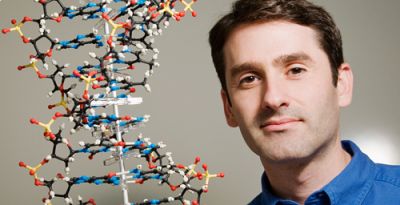According to researchers from the University of Illinois, better tools for laboratory experiments on DNA. could soon be possible thanks to the discovery of a new substance - deoxyribozymes (DNA catalytic) - capable of cleaving DNA. single strand

According to researchers from the University of Illinois, better tools for laboratory experiments on DNA. could soon be possible thanks to the discovery of a new substance - deoxyribozymes (DNA catalytic) - capable of cleaving DNA. single strand The new substance performs the DNA cleavage. while sequence selectivity and location selectivity, two properties required for practical acceleration, the researchers note.
"Our research indicates that the material has the potential to act as a selective DNA-cleaving reagent," said research chemist Professor Scott Silverman. "Our hope is that we can use this fundamental advance to develop the ability to use DNA. as a practical catalyst for DNA cleavage double-stranded.” The research findings were accepted for publication in the scientific journal Nature Chemical Biology.
The researchers discovered the new material while picking up DNA sequences. artificial ones that can break down proteins. The newly discovered catalysts work in a similar way to restriction enzymes (restriction enzymes) - enzymes capable of cutting DNA segments in very specific regions - although they only do this on DNA. single strand Restriction enzymes, which allow scientists to cut and paste segments of DNA. Double-stranded, are the most basic catalysts in molecular biology.
However, each restriction enzyme has a specific number of DNA sequences. that he can cut As a result, only a few percent of DNA sequences can be cut. arbitrary using the commercially available restriction enzymes.
Similar to natural restriction enzymes, the new catalysts are also sequence-directed and site-directed. "In other words - we are able to direct the cutting to a certain sequence and we know in advance that the cutting will take place in a specific and unique position within this sequence," explains the lead researcher. "Through an informed choice of the recognition and activity regions of the catalyst, we can cut DNA sequences. Many more than the number possible today with the restriction enzymes we know."
DNA catalysts The new ones require two metal ions - manganese and zinc - to carry out their catalytic activity. "This fact is extremely interesting because other natural protein-based substances that cleave DNA also require two metal ions for their proper activity," the researcher points out. "We assume that one or even both metal ions are involved in the chemical mechanism by which our new catalyst succeeds in hydrolyzing the DNA backbone."
DNA hydrolysis is an extremely challenging chemical reaction and is much more complex than the cleavage of an RNA strand, notes the lead researcher. In DNA cleavage It is mandatory that a water creature be present nearby for the reaction to take place. In addition, both DNA and the catalyst must be positioned in a certain way relative to each other in three-dimensional space. It is not yet clear how these actions occur for the new catalyst. The group of scientists continues to investigate the structure and mechanism of the new catalysts, as well as locates and characterizes catalysts with different and diverse recognition regions.
